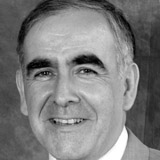 There is a long tradition in medicine of accepting a degree of mismatch between labels and the functions that they address. A classic example is the stethoscope, through which few of us peer, but which only a terminal pedant would now agitate to be renamed a stethophone.
There is a long tradition in medicine of accepting a degree of mismatch between labels and the functions that they address. A classic example is the stethoscope, through which few of us peer, but which only a terminal pedant would now agitate to be renamed a stethophone.
Recent debate over the redesignation of dementia as “major neurocognitive disorder” in the new DSM-V criteria highlights how the widespread acceptance of a somewhat less accurate descriptor may be more beneficial in terms of engagement with the public and among disciplines.
So, during the Berzelius symposium last month, I was surprised to come across a troubling barrier to developing better care for older people—the key adult users of health services—arising from resistance to an internationally accepted term.
The Berzelius symposium took place at the Swedish Society of Medicine’s building in Stockholm. Based in an early gem of Swedish national romantic architecture—analogous to the best of the Wiener Werkstätte or Arts and Crafts movements— the society honours one of its founders, the great physician chemist, Jöns Jakob Berzelius, through eponymous symposia.
Among Berzelius’s many achievements were the discovery of several elements and the invention of the symbols for the elements in the periodic table. His Nordic wit is characterised by his dictum that a tidy laboratory means a lazy chemist.
Last month’s symposium, the 88th in the series, was dedicated to personalised geriatric medicine. Given that the basis of geriatric medicine is to respond to the increased inter-individual variability of later life, the title may seem tautological, but in reality all too many health systems persist with a one size fits all approach to older people.
In addition, the phrase “personalised medicine” is often associated with a narrow matching of therapy to genotype rather than phenotype. This is somewhat ironic, given that the key intervention of geriatric medicine, the Comprehensive Geriatric Assessment (CGA), delivers personalised medicine now, whereas that promised by genomic analysis is both distant and likely to be niche based rather than universally applied.
Geriatricians and experts in associated disciplines from Europe, Japan, and the USA probed and dissected the two leading hot topics into geriatric medicine: frailty and CGA. Keynote lectures were nicely aerated by long discussions, and workshops with practitioners kept academic theory suitably moored to quotidian realities, resulting in a particularly rewarding and collegial symposium.
Developments in clinical operationalisation of frailty, with the promise of both prevention and treatment, have caught the attention of many disciplines outside of geriatric medicine in recent years. Two key points arose from the discussions: the need to view frailty as an indicator for more attentive age attuned care, rather than as a barrier to effective interventions, and the need for delineation of evidence based remediation in frailty and pre-frailty.
The discussion on CGA—a very effective intervention with a potency similar to that of stroke units—focused on operationalisation: from analysis of its necessary components to diffusion in settings outside of the hospital. The presentations from the USA and Japan were very illuminating in this regard.
A stark contrast to the intellectual and professional ferment of the meeting was the sharing of a troubling report that the term CGA is being rejected in a Swedish health technology assessment on the basis: a) that the term specifies “assessment,” despite the fact that the whole literature clearly is directed to interventions as a part of CGA; b) that “geriatric” was in the title (this remains the standard phrase for the medical discipline throughout the world); and c) that there were not geriatricians in every county in Sweden. This latter point is truly daft—would the implementation of stroke units in earlier years not have been promoted because there was not a stroke physician or team in every hospital?
Berzelius might have sympathised with the debacle. His system of atomic symbols was a pragmatic and sensible approach to naming the elements, but took many years to be adopted widely.
A number of proposals were mooted at the meeting to rename CGA so as to more specifically include the key elements of the intervention inherent in its execution: prevention, rehabilitation, and management.
However, in some ways it seems just as important to tackle the root causes of the unhappy combination of pedantry and gerontological illiteracy, which is blocking promotion of effective acute care for older people in an otherwise progressive Nordic country.
Desmond (Des) O’Neill is a geriatrician and cultural gerontologist in Dublin. He is also the local lead for the IAGG-ER Congress in 2015.
